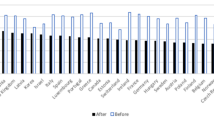Abstract
This paper has analysed the composition of public expenditure and its impact on per capita income in major states of India. The study finds that the share of revenue expenditure in total spending of the government has increased in all the states although its effect on growth is negative. The share of capital expenditure, government spending on infrastructure, agricultural productivity, gross capital formation and share of service sector in net state domestic product have significant positive impact on per capita income. The paper has explained the political economy of public expenditure and contributed to the literature by using theoretical framework in growth process and incorporating other factors as control variables in panel regression. It has tried to explain why the government spends more on the unproductive or less productive heads in the revenue account at the cost of long-run growth. This paper argues that the government in a democratic set-up allocates a greater share of funds to distributive purposes to strengthen its support base. The results of panel regression show that if the government remains in power for a long period, the share of revenue expenditure will be higher in total spending. The effect of coalition government is, however, uncertain.
Similar content being viewed by others
References
Afonso A, Furceri D (2010) Government size, composition, volatility and economic growth. Eur J Polit Econ 26(4):517–532
Agenor PR (2008) Fiscal policy and endogenous growth with public infrastructure. Oxf Econ Pap 60(1):57–87
Ahmad M (2014) Government expenditure and economic growth: an econometric test for India. Int J Soc Sci Humanit Res 2(3):79–88
Alesina A, Rodrick D (1994) Redistributive politics and economic growth. Quart J Econ 109(2):465–490
Aschauer D (1989) Is government spending productive? J Monet Econ 23:177–200
Banerjee AV, Newman AF (1993) Occupational choice and the process of development. J Polit Econ 101(2):274–298
Barro RJ (1990) Government spending in a simple model of endogenous growth. J Polit Econ 98(5):S103–S125
Barro RJ (1991) Economic growth in a cross section of countries. Quart J Econ 106(2):407–444
Bruce N, Turnovsky SJ (1999) Budget balance, welfare and the growth rate: “dynamic scoring” of the long-run government budget. J Money Credit Bank 31(2):162–186
Chen BL (2006) Economic growth with an optimal public spending composition. Oxf Econ Pap 58(1):123–136
Chiang AC (1992) Elements of dynamic optimisation. McGraw-Hill, New York
Devarajan S, Swaroop V, Zou H (1996) The composition of public expenditure and economic growth. J Monet Econ 37(2):313–344
Galor O, Zeira J (1993) Income distribution and macroeconomics. Rev Econ Stud 60(1):35–52
Gangal VLN, Gupta H (2013) Public expenditure and economic growth: a case study of India. Global J Manag Bus Stud 3(2):191–196
Ghosh S, Gregoriou A (2008) The composition of government spending and growth: is current of capital spending better? Oxf Econ Pap 60(3):484–516
Gnangoin YTB, Du L, Assamoi GR, Edjoukou AJR, Kassi DF (2019) Public spending, income inequality and economic growth in Asian countries: a panel GMM approach. Economics 7(4):115
Kalaitzidakis P, Tzouvelekas V (2011) On the growth and welfare maximizing allocation of public investment. J Econ 104(2):127–137
Leeper EM, Walker TB, Yang SCS (2010) Government investment and fiscal stimulus. J Monet Econ 57(8):1000–1012
Magazzino C, Forte F (2016) Government size and economic growth in Italy: a time series analysis. Eur Sci J 12(7):149–169
Mahapatra G, Giri AK (2016) The composition of public expenditure and economic growth in India: evidence from auto regressive distributed lag approach. J Econ Res 21:205–230
Marjit S, Maity D (2006) Politics and contemporary macroeconomy of India. India Macroeconomics Annual, Centre for Studies in Social Sciences. Sage Publications Ltd, New Delhi, pp 9–55
Marjit S, Mukherjee V, Kolmar M (2006) Poverty, taxation and governance. J Int Trade Econ Dev 15(3):325–333
Marjit S, Sasmal J, Sasmal R (2013) Distributive politics, public expenditure and economic growth: evidences from Indian states. Paper presented at international ‘DIAL’ development conference, Dauphine University, Paris, France
Marrero GA (2010) Tax-mix, public spending composition and growth. J Econ 99(1):29–51
Meltzer AH, Richard SF (1981) A rational theory of the size of the government. J Polit Econ 89(51):914–927
Persson T, Tabellini G (1994) Is inequality harmful for growth? Am Econ Rev 84(3):600–621
Reserve Bank of India. Handbook of statistics on state finances, 2010, 2017
Saez MP, Garcia SA, Rodriguez DC (2017) Government expenditure and economic growth in the European Union countries: new evidence. Bull Geogr Socio-Econ Ser 36:127–133
Sarkar A (2006) Political economy of West Bengal: a puzzle and a hypothesis. Econ Polit Wkly 61(4):341–348
Sasmal J (2011) Distributive politics, nature of government spending and economic growth in a low income democracy. J Econ Finance Adm Sci 16(30):31–46
Sasmal R, Sasmal J (2016) Public expenditure, economic growth and poverty alleviation. Int J Soc Econ 43(6):604–618
Sasmal J, Sasmal R (2018) Public debt, economic growth and fiscal balance: alternative measures of sustainability in the Indian context. Global Bus Rev 21(2):1–20
Seshaiah SV, Reddy TK, Sharma IRS (2018) General government expenditure and economic growth in India: 1980–81 to 2015–16. Theor Econ Lett 8:728–740
Wooldridge JM (2009) Econometrics. Cengage Learning, Mason
Zhang L (2015) A Multi-sector model of public expenditure and growth. J Econ 115(1):73–93
Author information
Authors and Affiliations
Corresponding author
Additional information
Publisher's Note
Springer Nature remains neutral with regard to jurisdictional claims in published maps and institutional affiliations.
Rights and permissions
About this article
Cite this article
Marjit, S., Sasmal, R. & Sasmal, J. Composition of public expenditure and growth of per capita income in Indian states: a political perspective. J. Soc. Econ. Dev. 22, 1–17 (2020). https://doi.org/10.1007/s40847-020-00097-y
Published:
Issue Date:
DOI: https://doi.org/10.1007/s40847-020-00097-y
Keywords
- Political economy
- Distributive policies
- Capital expenditure
- Revenue expenditure
- Capital formation
- Economic growth




